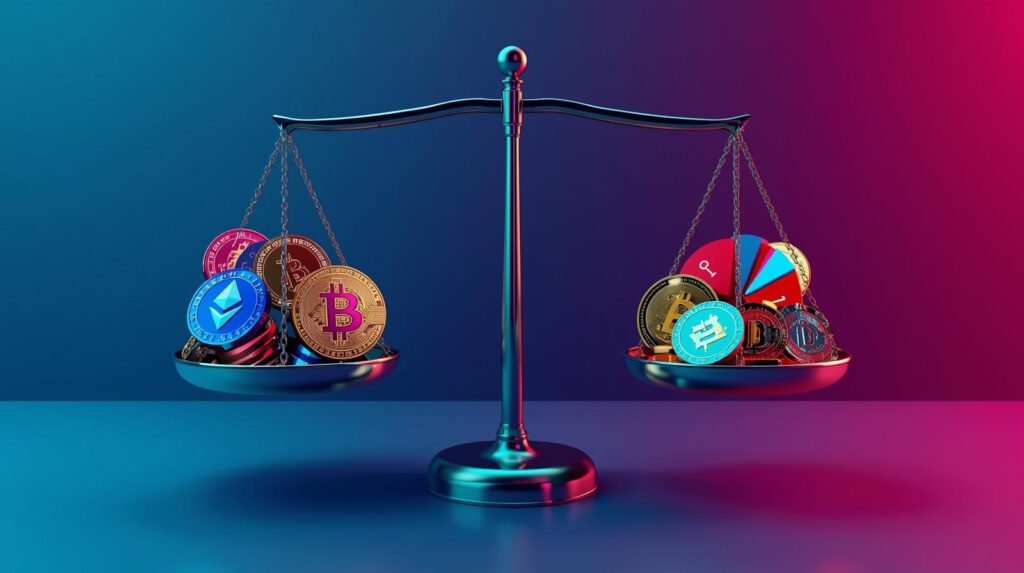Table of Contents
Understanding the Latest Crypto Market Crash
The crypto market crash has become an all-too-familiar headline in 2025. If you’ve been watching Bitcoin prices lately, you’ve probably felt the roller coaster firsthand. Just when things seem stable, another crash hits—wiping out billions in value overnight and leaving investors wondering if they should panic sell or buy the dip.
The most recent crash in October 2025 saw Bitcoin plummet below $110,000, tumbling over 10% in just 24 hours. Ethereum, XRP, and Solana got hit even harder—some dropping 15-30%. Over $5 billion in leveraged positions got liquidated, meaning traders who borrowed money to amplify their bets got completely wiped out.
But here’s what’s really interesting: this wasn’t some mysterious event. The trigger? President Trump announced a 100% additional tariff on China, sending global markets—including crypto—into a tailspin. And that’s the pattern we keep seeing: crypto crashes aren’t happening in a vacuum. They’re tied to real-world events, policy changes, and macroeconomic forces that most retail investors don’t see coming.

The Real Reasons Behind Recurring Crypto Crashes
Understanding why crypto market crashes happen so frequently requires looking at multiple interconnected factors. It’s not just about one thing going wrong—it’s usually a perfect storm of issues hitting all at once.
Global Economic and Political Instability
Cryptocurrencies are incredibly sensitive to geopolitical tensions and macroeconomic shifts. According to recent market analysis, US-China trade tensions have been a major driver of volatility. When the dollar surges or inflation data surprises markets, crypto feels the impact immediately—often more dramatically than traditional assets.
Why? Because crypto is still seen as a risk-on asset. When investors get nervous about the economy, they pull money out of risky investments and move it to “safer” places like bonds or gold. Crypto gets sold off first.
Excessive Leverage and Liquidation Cascades
Here’s something most casual crypto investors don’t realize: a huge portion of crypto trading involves leverage—basically borrowing money to make bigger bets. When prices drop suddenly, these leveraged positions get automatically closed (liquidated) to prevent losses for lenders. But those forced sells push prices down further, triggering more liquidations, creating a cascade effect.
In the recent crash, over $5 billion in leveraged positions were liquidated in a single day. That’s not natural selling—that’s forced liquidations amplifying a normal price decline into a catastrophic crash.
Lack of Fundamental Value Anchors
Traditional stocks have earnings, assets, and cash flows you can analyze to determine fair value. Crypto? Not so much. Bitcoin’s value is based on… what people think it’s worth. That’s it. No earnings reports, no dividend payments, no tangible assets backing it up. This makes crypto incredibly susceptible to sentiment shifts and speculation.
Regulatory Uncertainty
Governments worldwide are still figuring out how to regulate crypto, and that uncertainty creates volatility. One negative regulatory announcement—whether it’s China cracking down on mining, the SEC going after exchanges, or new tax policies—can trigger massive selloffs. As detailed by cryptocurrency risk analysts, regulatory risks remain one of the top concerns for both retail and institutional investors in 2025.
Market Manipulation and Whale Activity
The crypto market is still relatively small compared to traditional finance, making it easier for large holders (whales) to manipulate prices. A few major holders dumping their positions can trigger panic selling among retail investors, creating crashes that wouldn’t happen in more liquid, regulated markets.
Traditional Market Crash vs. Crypto Market Crash: Key Differences
Not all market crashes are created equal. Here’s how crypto market crashes differ from traditional stock market corrections:
| Factor | Traditional Stock Market Crash | Crypto Market Crash |
|---|---|---|
| Frequency | Major crashes every 5-10 years | Significant crashes multiple times per year |
| Speed | Typically unfolds over days or weeks | Can happen in hours or even minutes |
| Magnitude | 10-20% considered severe correction | 30-50% drops are routine, 80%+ drops possible |
| Recovery Time | Months to years | Highly variable – days to years |
| Trading Hours | Limited to market hours (9:30am-4pm ET) | 24/7 trading means crashes happen anytime |
| Circuit Breakers | Automatic trading halts prevent panic | No circuit breakers – crashes can accelerate unchecked |
| Leverage Impact | Some leverage available, regulated | 100x+ leverage common, creates liquidation cascades |
| Fundamental Value | Assets backed by earnings, dividends, tangible value | Purely speculative, no fundamental value anchor |
What Experts Say vs. What Retail Investors Experience
There’s often a huge disconnect between how analysts describe crypto market crashes and what actual investors go through. Let’s look at both perspectives.
The Expert Perspective
Professional analysts and institutional investors typically view crypto crashes as predictable volatility events driven by identifiable macroeconomic factors. According to institutional crypto strategy research, 67% of firms are actually planning to increase crypto holdings in 2025, with 91% acknowledging volatility as their main risk but considering it manageable within a diversified portfolio.
Institutional players have risk management systems, diversified portfolios, and long time horizons. They see crashes as buying opportunities and portfolio rebalancing events. Many institutions allocate only 1-5% of total assets to crypto specifically because of volatility, meaning even a 50% crypto crash barely moves their overall portfolio needle.
The Retail Investor Reality
For regular people investing in crypto? The experience is completely different. Many retail investors are overexposed—putting 20%, 50%, or even 100% of their savings into crypto because of FOMO (fear of missing out) and promises of getting rich quick. When crashes hit, these investors experience:
- Panic and emotional decision-making: Watching life savings evaporate in hours triggers panic selling at the worst possible time
- Leverage disasters: Retail traders using borrowed money get completely wiped out through liquidations
- No hedging strategies: Unlike institutions, most retail investors don’t hedge or protect their positions
- Portfolio concentration: All eggs in one basket means crashes are financially devastating
- Inability to wait out crashes: Need to access money for living expenses forces selling at losses
The emotional toll is real. Online crypto communities during crashes are filled with people describing panic attacks, relationship stress, and genuine financial hardship. That’s the human cost that analytical reports don’t capture.

Proven Strategies to Protect Your Crypto Portfolio
Okay, enough doom and gloom. Let’s talk about how you can actually protect yourself during crypto market crashes and build a more resilient portfolio. These aren’t get-rich-quick schemes—they’re practical risk management strategies that actually work.
1. Position Sizing and Diversification
The single most important protection strategy is not putting too much money into crypto in the first place. As covered in our comprehensive guide on smart investment strategies, financial advisors typically recommend keeping crypto exposure to 5-10% of your total investment portfolio maximum.
Within your crypto allocation, portfolio experts recommend dedicating 60-70% to Bitcoin and Ethereum as foundational assets, with the remaining 30-40% spread across promising altcoins. This creates a barbell strategy—stability plus upside potential.
2. Dollar-Cost Averaging (DCA)
Instead of trying to time the market (which nobody can do consistently), invest fixed amounts at regular intervals regardless of price. This strategy, detailed in our personal finance tips for 2025, means you automatically buy more when prices are low and less when prices are high. Over time, this smooths out volatility and removes emotion from investment decisions.
3. Never Use Leverage
Seriously. Just don’t. The leverage that crypto exchanges offer (50x, 100x, even higher) is financial suicide waiting to happen. Sure, leverage amplifies gains when you’re right, but it completely wipes you out when you’re wrong—and in volatile crypto markets, even experienced traders are wrong frequently. Every major crypto market crash is accompanied by billions in liquidated leveraged positions. Don’t be part of that statistic.
4. Keep Emergency Reserves in Stable Assets
According to crypto portfolio protection strategies, smart investors keep 10-20% of their crypto portfolio in stablecoins (USDC, USDT) or fiat currency. This serves two purposes: you have dry powder to buy during crashes, and you have funds you can access without being forced to sell during downturns.
5. Use Cold Storage for Long-Term Holdings
If you’re holding crypto long-term, get it off exchanges and into cold storage wallets you control. This prevents exchange hacks, freezes, or bankruptcies from affecting your holdings. It also creates psychological separation—if accessing your crypto requires physical effort, you’re less likely to panic sell during crashes.
6. Set and Stick to Exit Strategies
Before buying any crypto, decide your exit strategy. At what profit do you take some off the table? At what loss do you cut your position? Having predetermined rules prevents emotional decision-making during volatility. Many successful investors use a simple rule: sell 25% when an investment doubles, securing their original investment while leaving 75% for potential further gains.
7. Educate Yourself Continuously
Understanding the technology, market dynamics, and macroeconomic factors that drive crypto prices gives you conviction during crashes. As explored in our article on AI and financial planning, informed decision-making based on understanding rather than emotion is key to long-term investment success.
The Psychological Side: Managing FOMO and Fear
Technical strategies are important, but the psychological aspect of surviving crypto market crashes is equally critical. The two biggest emotional killers are FOMO (fear of missing out) and panic during crashes.
Conquering FOMO
FOMO drives people to invest at market tops when prices have already run up dramatically. Everyone’s talking about crypto, mainstream media is covering it, your neighbor just made money—so you jump in right before a crash. Sound familiar? The solution is having a plan and sticking to it regardless of what others are doing. If your plan is to DCA a fixed amount monthly, do that whether Bitcoin is at $50k or $150k.
Dealing with Crash-Induced Panic
When crashes hit, the urge to “do something” is overwhelming. But often, doing nothing is the right move. Before panic selling, ask yourself: has anything fundamental changed about why you invested? If you bought Bitcoin believing in long-term adoption and that hasn’t changed, why would a temporary price drop matter? Having this mental framework prepared before crashes happen makes rational decision-making possible during emotional moments.

The Road Ahead: What’s Next for Crypto Markets
Will crypto market crashes keep happening? Almost certainly. Volatility is inherent to crypto’s nature as a young, speculative asset class with limited fundamental anchors and 24/7 global trading. But understanding that volatility is the price you pay for potential outsized returns helps set realistic expectations.
Some positive trends to watch: increasing institutional adoption, maturing market infrastructure, clearer regulatory frameworks (eventually), and Bitcoin ETFs bringing more traditional investment into the space. These factors may gradually reduce volatility over time, though crypto will likely remain more volatile than traditional assets for the foreseeable future.
The key is positioning yourself to survive the crashes and benefit from the recoveries. Historically, crypto has always recovered from crashes—though past performance doesn’t guarantee future results. The investors who succeeded long-term weren’t the ones who predicted crashes or timed markets perfectly. They were the ones who managed risk, controlled emotions, and stayed invested through the volatility.
For more insights on managing personal finances and investment strategies, explore our Related Personal Finance Post section.
Conclusion: Surviving and Thriving Through Crypto Volatility
The crypto market crash phenomenon isn’t going away anytime soon. Understanding why crashes happen—macroeconomic factors, excessive leverage, sentiment shifts, and regulatory uncertainty—helps you prepare mentally and financially. The difference between investors who get wiped out and those who build wealth isn’t luck or timing. It’s risk management, diversification, and emotional discipline.
Protect your portfolio by limiting crypto exposure to what you can afford to lose, never using leverage, diversifying across assets, and having predetermined exit strategies. Manage emotions by educating yourself, avoiding FOMO, and accepting volatility as part of the crypto investment thesis. And remember: crashes create opportunities for those who are prepared, positioned correctly, and thinking long-term.
The crypto market will keep crashing. The question isn’t whether another crash will happen—it’s whether you’ll be prepared when it does. Build your strategy now, before the next crash, because once it starts, emotion takes over and rational planning becomes nearly impossible.
Stay tuned for more crypto and finance insights on Newspuf. We’re tracking market developments, analyzing trends, and providing practical guidance to help you navigate this volatile but potentially rewarding asset class. If you have questions or want to share your experience, contact us—we’re here to help you make informed decisions about your financial future.
Frequently Asked Questions About Crypto Market Crashes
How long do crypto market crashes typically last?
Crypto crashes are highly variable in duration. The initial price drop usually happens within hours or days, but full recovery can take anywhere from weeks to years depending on the cause and severity. The 2018 crypto crash saw Bitcoin fall from $20k to $3k, taking nearly three years to recover. The 2021 crash recovered in months. The key lesson? Don’t invest money you’ll need in the short term, and be prepared to wait out extended downturns if necessary. Dollar-cost averaging during crashes can actually accelerate recovery of your portfolio value.
Should I sell when a crypto crash starts or hold for recovery?
For most long-term investors, holding through crashes typically produces better outcomes than panic selling. Historically, crypto markets have recovered from every crash, though past performance doesn’t guarantee future results. However, this assumes you invested an appropriate amount you can afford to lose and didn’t use leverage. If a crash is causing genuine financial hardship or keeping you up at night, your position may have been too large to begin with. The best time to decide your exit strategy is before crashes happen, not during them when emotions run high.
What percentage of my investment portfolio should be in crypto?
Most financial advisors recommend limiting crypto to 5-10% of your total investment portfolio, with some suggesting even lower allocations. This ensures that even a complete crypto collapse wouldn’t devastate your overall financial situation. If you’re young, have high risk tolerance, and can afford losses, you might go slightly higher. If you’re near retirement or have low risk tolerance, keep it at 1-5% or avoid crypto entirely. The key principle: only invest what you can afford to lose completely without affecting your financial stability or mental health.
Are crypto crashes good buying opportunities?
Crashes can present buying opportunities, but trying to catch exact bottoms is nearly impossible and often backfires. A smarter approach is dollar-cost averaging—investing fixed amounts at regular intervals during and after crashes rather than trying to time a single perfect entry. This way, if the crash continues, you keep buying at lower prices. If it rebounds quickly, you still got in at better prices than before the crash. Remember that some crashes represent fundamental problems (exchange collapses, major hacks, regulatory crackdowns) while others are temporary volatility. Understanding the difference is crucial.
How can I protect my crypto from exchange failures during market crashes?
The safest approach is keeping long-term crypto holdings in cold storage wallets you control, not on exchanges. Hardware wallets like Ledger or Trezor give you complete control of private keys, protecting against exchange hacks, bankruptcies, or freezes. Only keep crypto on exchanges if you’re actively trading it. During crashes, exchange failures and liquidity crunches can happen, potentially locking your funds. The crypto saying “not your keys, not your coins” is especially important during volatile periods when exchange stability gets tested most severely.




